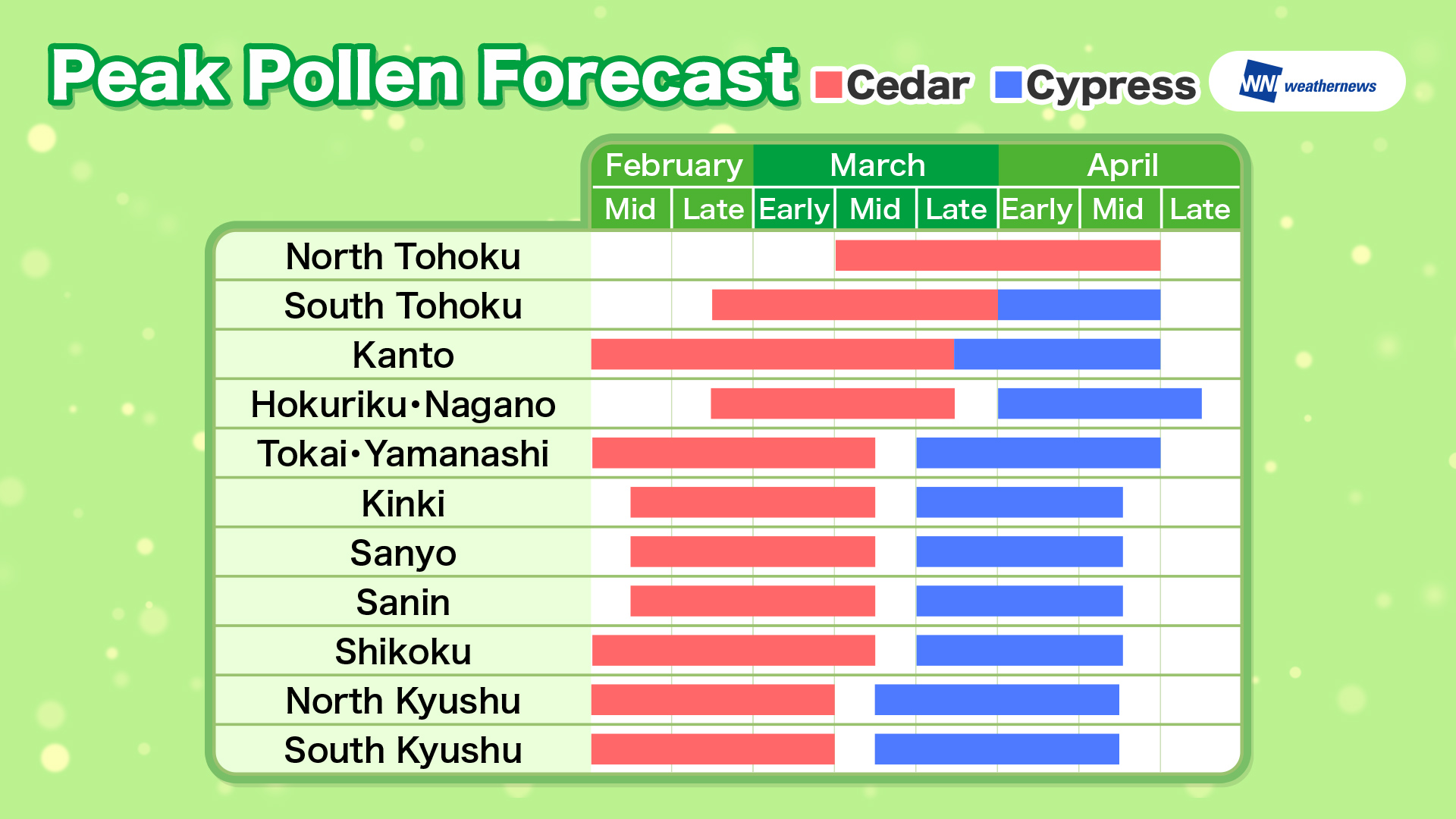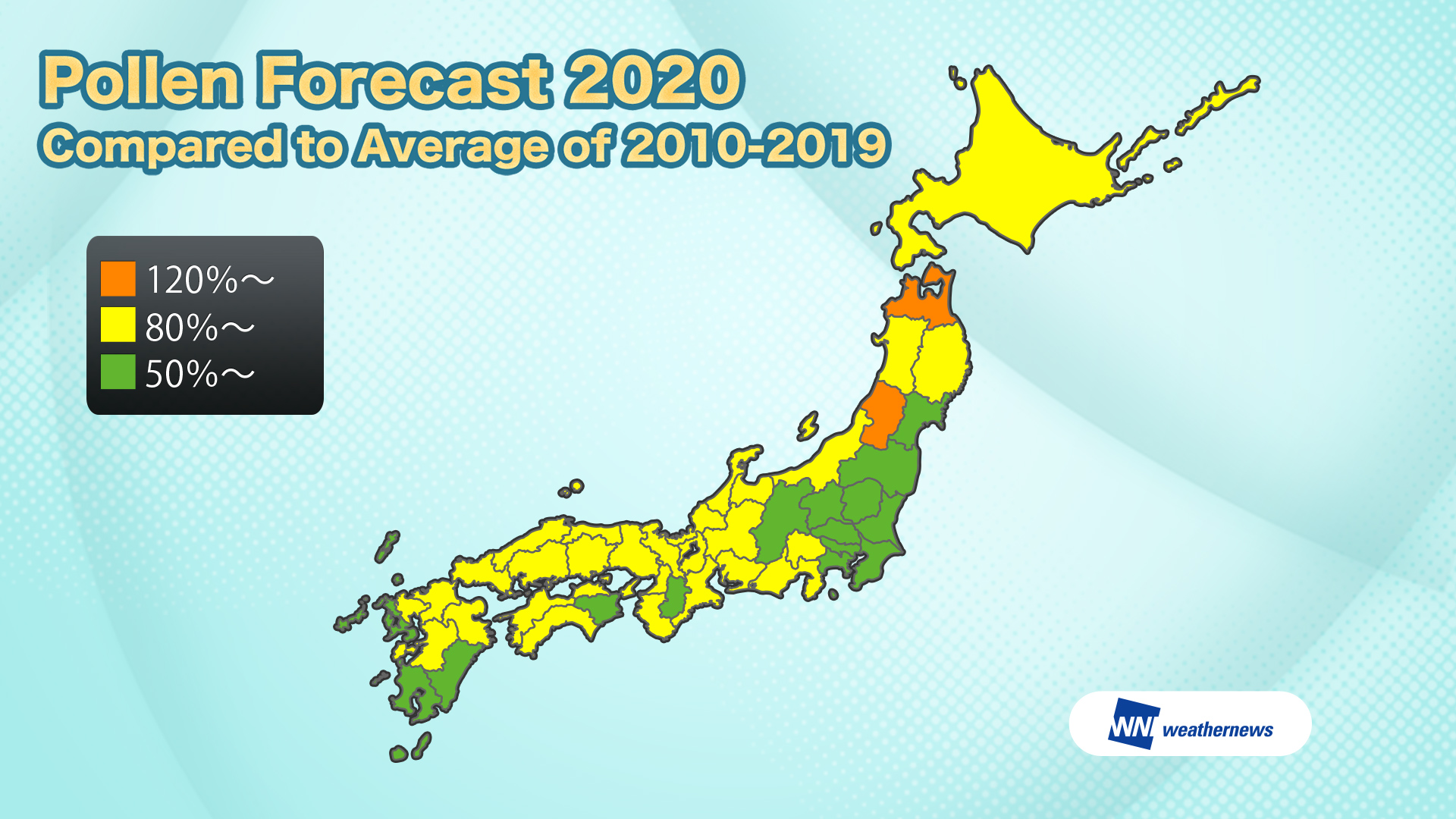News & Press Release
Announcing Pollen Trends for Japan! The "Pollen Robo" observation device detects cedar pollen
Hay fever season has started early after a warm winter
Mobile/Internet >Weathernews Inc. has announced the start of Japan's hay fever season as of February 6th, based on higher than normal pollen levels observed by their Pollen Robo devices in areas from southern Kanto to Tokai, southern Kinki, Chugoku, Shikoku, and northern Kyushu, combined with user reports of hay fever symptoms and expectations of increasing pollen dispersal going forward. Although the onset of hay fever season in the southern Kanto region was roughly in line with the average year, due to record-breaking warm winter weather the season began around 5 to 10 days earlier than normal in other prefectures, such as those in the Tokai region and northern Kyushu. In mid-February the peak period for cedar pollen dispersal is expected to begin earlier than usual in all areas of western Japan and eastern Japan other than Hokuriku.
Hay fever season has begun in Tokyo and 14 prefectures
Based on the combination of higher than normal *1 pollen dispersal levels observed by Pollen Robo pollen measuring devices in 14 prefectures including Tokyo, Kanagawa, Chiba, Saitama, Yamanashi, Shizuoka, Aichi, Mie, Wakayama, Yamaguchi, Ehime, Fukuoka, Nagasaki, Oita, and parts of Kumamoto, together with the fact that pollen dispersal is expected to increase going forward and a growing number of user reports of "severe" or "somewhat severe" hay fever symptoms, Weathernews has announced that Japan has entered the hay fever season.
Although the start of the hay fever season is roughly in line with the average year in the Kanto region, it began around five to 10 days earlier than usual in other areas, such as the Tokai region and northern Kyushu.
*1 Criteria: More than 30% of the Pollen Robo observing devices have detected 10 or more grains of pollen per day
Expected start of dispersal: Both the start of dispersal and peak levels are expected to be early in various places due to a record-breaking warm winter
The unusually warm winter has resulted in a wide area across western and eastern Japan entering the hay fever season early. It is possible that full-scale dispersion may begin in the Kanto, Tokai, and northern Kyushu regions, etc. where the hay fever season has already begun. It is expected that dispersal will begin in the Tohoku region as well from late February. Both the start and the peak of dispersal may occur earlier than normal due to the warm winter.
In addition, pollen began to disperse gradually before the start of the season, and a survey conducted from the 4th to the 5th of February found that more than half of hay fever patients had begun to feel symptoms * 2. Taking early measures against pollen is recommended even for those living in areas where the hay fever season has yet to begin.
*2 Survey method: Users of the Weathernews app were asked, "Are you feeling the effects of pollen?" Responses could be selected from among, "I do not get hay fever", "I feel no symptoms", "I feel some symptoms", and "I feel significant symptoms". (Survey period: February 4th to 5th; number of responses: 7,094; Hokkaido and Okinawa were excluded.)
Peak dispersal forecast: In Kanto, Kyushu, and Shikoku, cedar pollen levels will peak in mid-February and Japanese cypress pollen levels will peak in late March
Pollen dispersal will be in full swing about one week to ten days after the start of hay fever season. In mid-February, we expect peak levels of cedar pollen dispersal throughout western and eastern Japan, except for Hokuriku. Peak cedar pollen dispersal levels are also expected in Hokuriku and Tohoku between late February and mid-March.
Cedar pollen dispersal will gradually decrease from peak levels in the latter half of March, when cypress pollen dispersal will increase, starting in western Japan. Cypress pollen levels are expected to peak from mid-March to mid-April, mainly in western and eastern Japan. In Honshu, dispersal of cypress pollen normally ends in early May, but this year is expected to be over by the end of April.
In Hokkaido, dispersal of pollen from Japanese white birch trees is expected to reach peak levels in the southern and central areas around Golden Week (end of April to early May), and mid-May in the northern and eastern areas.
Estimated dispersal volume: Below average nationwide; the national average will be 85% of normal years; volume will be less than half of 2019 in some regions
Although the total annual volume of pollen dispersal from cedar and cypress trees is forecast to be higher than normal in parts of Tohoku, it is expected to be lower than average throughout almost all of Japan. The national average is expected to be around 85% of the average year.
In addition, pollen dispersal volumes are expected to be below 2019 levels in most regions except for some parts of northern Japan, and in some areas they will be less than half of 2019 levels. However, even when total volumes are small, large amounts of pollen may be dispersed over short time periods or in particular areas.
Developing Japan's largest pollen observation network
Since 2005, Weathernews has been running the Pollen Project, an initiative based on user participation that aims to help people who suffer from hay fever. The Pollen Project monitors pollen levels in real time, 24 hours a day, with the cooperation of volunteers who install a pollen observation device called the Pollen Robo at approximately 1,000 homes, hospitals, and companies all across Japan. The Pollen Robo automatically records the amount of pollen in the air over a 24-hour period and transmits the data to Weathernews. Weathernews uses this observation data to announce pollen dispersal trends and daily forecasts.



